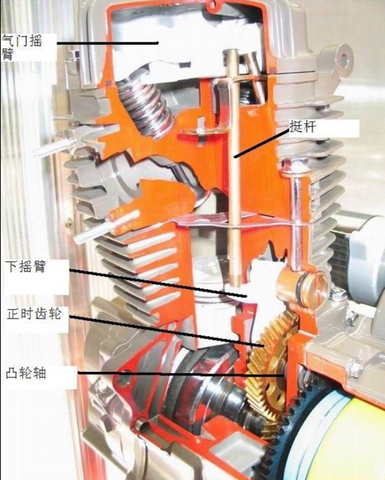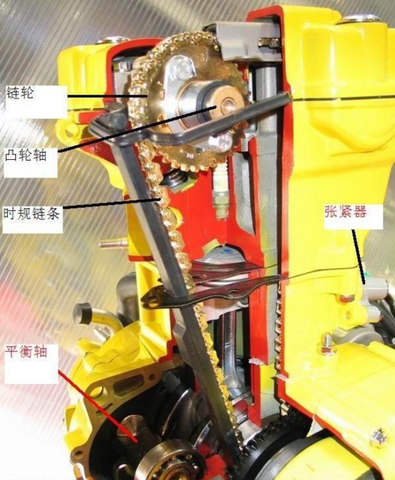Comparison between CB & CG Engines
The crankshaft timing gear meshes with the camshaft gear.
When the engine is running, the crankshaft rotates.
The crankshaft timing gear drives the camshaft gear to rotate.
The camshaft rotates with the camshaft gear, so that the cam follower (lower rocker arm) oscillates with the undulation of the cam curve.
The swing of the lower rocker arm causes the ejector to move up and down, and then through he transmission of the valve rocker arm,
the intake and exhaust valves are opened and closed according to the law of the cam profile.

Cam profile:
Because the air flow at the inlet and outlet is proportional to the lift of the valve.
The larger the valve lift, the greater the valve opening, the greater the area of valve flow cross-section, the greater the air flow.
The curve height of the cam can control the lift of the valve, thus controlling the intake and exhaust volume of the cylinder at different working stages.
Therefore, a reasonable cam profile is very important for engine work.
Working characteristics
In the valve train, the mandril is reciprocating and the inertia is large.
When the engine is running at high speed, the ejector rod moves up and down at a high speed of tens of times per second, which impacts the lower rocker arm and the valve rocker arm and produces impact noise.
In addition, there will be mesh noise between the high speed rotating crankshaft timing gear and the camshaft gear.
The higher the engine speed, the greater the noise.
The high speed impact of the ejector rod on the lower rocker arm and the valve rocker arm causes the wear surface of the joints to be very large.
High speed reciprocating parts produce a great impact load, which aggravate the wear between engine parts.
The engine runs unstable and vibrates greatly. Reciprocating motion of ejector pin and other components.
The resulting inertia force acts on the valve rocker arm, resulting in valve closing at high speed.
It's too late. Too late intake valve will cause mixture backflow and pressure loss. The exhaust valve is too late to cause flammable combustion.
Gas leakage, fuel consumption rise and exhaust emissions increase.
Because the camshaft is located at the lower part, there are too many transmission parts between the cam and the rocker arm, and the rigidity of the valve train is poor.
When the engine is running, these parts produce deformation and vibration under periodic force, which makes the valve movement law distorted.
The valve opening and closing time and amplitude deviate from the cam profile, and the valve timing of the engine is inaccurate. It will cause power loss and fuel consumption increase.
Timing chain valve train (CB)
The chain wheel fixed on the left crank rotates with the crankshaft and drives the camshaft sprocket to rotate through the chain.
The rotation of the camshaft causes the valve rocker to swing up and down, and control the intake and exhaust valves to open and close on time.

High-speed motorcycle engine is the development direction of motorcycles, because the chain valve train has superior high-speed performance, so the modern high-speed engine mostly adopts this structure.
The camshaft is arranged on the cylinder head, the number of transmission parts between the camshaft and the valve is small, the valve train is rigid, and the valve train phase is accurate.
The working noise of chain drive is small. Because the chain and sprocket are rotating, so the impact load is small, the engine runs smoothly, vibration is also small,
in high-speed state, this advantage is more prominent. However, due to the high speed movement of the chain, the chain has a high manufacturing accuracy.

Leave a comment